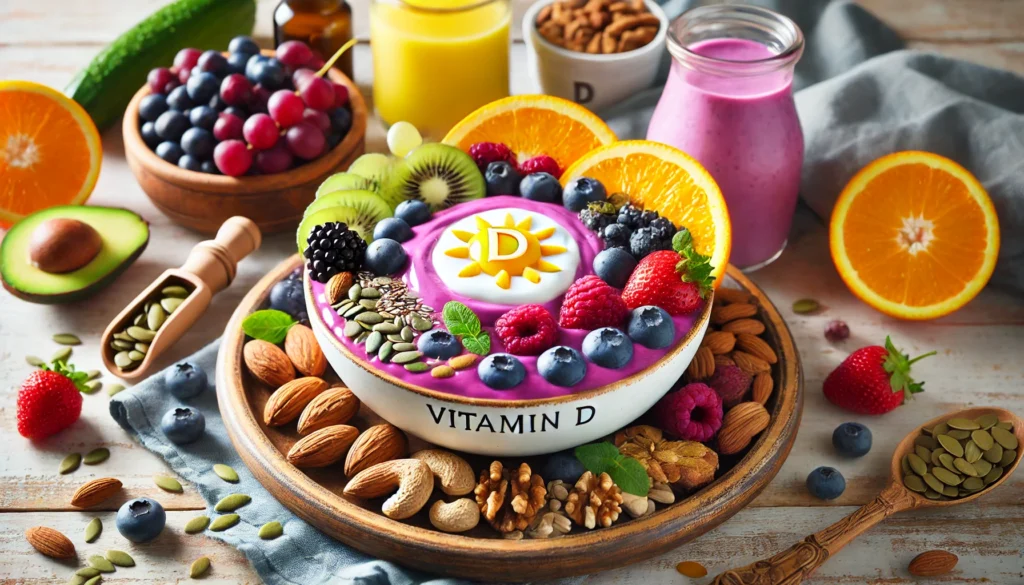Understanding Vitamin D and Its Importance
Vitamin D is an essential nutrient that plays a critical role in various bodily functions, particularly in bone health, immune system regulation, and cellular growth. Unlike other vitamins that are primarily obtained through diet, vitamin D is unique in that the body can synthesize it through exposure to sunlight. Despite its importance, many individuals fail to maintain adequate levels due to lifestyle factors, dietary restrictions, and underlying health conditions. Understanding the different forms of vitamin D, how it is absorbed, and strategies to enhance its uptake is essential for optimizing health outcomes.
You may also like: What Is Bioavailability in Nutrition? A Simple Explanation of How Nutrients Are Absorbed and Utilized
Vitamin D exists in multiple forms, but the most relevant to human health are vitamin D2 (ergocalciferol) and vitamin D3 (cholecalciferol). These forms have different origins and bioavailabilities, making it necessary to determine the best form of vitamin D for absorption. Vitamin D3, which is synthesized in the skin and found in animal-based foods, is generally considered more effective at raising blood levels of the nutrient compared to vitamin D2, which is plant-derived. However, absorption efficiency is influenced by several factors, including diet, gut health, and individual metabolic differences.

The Role of Sunlight in Vitamin D Synthesis
Sunlight exposure is the most natural way for the body to produce vitamin D. When ultraviolet B (UVB) rays from the sun interact with the skin, they trigger a series of chemical reactions that convert cholesterol into pre-vitamin D3, which is then transformed into active vitamin D3. However, several factors influence this process, including geographical location, seasonality, time of day, skin pigmentation, and the use of sunscreen. Individuals living in higher latitudes or urban environments with limited sun exposure are at a higher risk of vitamin D deficiency.
To optimize vitamin D synthesis from sunlight, experts recommend exposing the skin to direct sunlight for at least 10–30 minutes several times a week, depending on skin type and location. Lighter-skinned individuals require less time in the sun to produce adequate vitamin D, whereas those with darker skin need longer exposure due to higher melanin levels, which reduce UVB penetration. However, balancing sun exposure with skin cancer risk is essential, making it necessary to adopt other strategies to enhance vitamin D uptake when sunlight is insufficient.
Dietary Sources of Vitamin D
Although food sources provide less vitamin D compared to sunlight exposure, they remain an essential part of maintaining adequate levels, particularly for individuals with limited sun exposure. Fatty fish such as salmon, mackerel, and sardines are among the richest natural sources of vitamin D3. Cod liver oil is another potent source, providing high concentrations of the nutrient in a bioavailable form. Egg yolks and fortified dairy products also contribute to vitamin D intake, though in smaller amounts.
For plant-based eaters, vitamin D2 is found in fortified foods such as plant-based milk, cereals, and mushrooms exposed to ultraviolet light. However, as vitamin D2 is less effective at raising blood levels than vitamin D3, individuals relying on plant sources may require supplementation to meet their needs. The absorption of vitamin D from food is also influenced by dietary fat intake, as it is a fat-soluble vitamin. Consuming vitamin D-rich foods alongside healthy fats, such as avocados, nuts, and olive oil, enhances its bioavailability.
The Science of Vitamin D Absorption
Understanding how to maximize vitamin D absorption requires an appreciation of the physiological mechanisms involved. Once consumed through food or supplements, vitamin D is absorbed in the small intestine, where it is incorporated into chylomicrons and transported through the lymphatic system before reaching circulation. Several factors can enhance or inhibit this process, making it crucial to optimize conditions for efficient uptake.
One of the most important factors influencing vitamin D absorption is gut health. Individuals with gastrointestinal disorders such as Crohn’s disease, celiac disease, or irritable bowel syndrome may experience reduced vitamin D uptake due to impaired fat absorption. In such cases, alternative strategies, such as using liquid or emulsified vitamin D supplements, may improve bioavailability. Additionally, certain medications, including antacids, statins, and corticosteroids, can interfere with vitamin D metabolism, necessitating higher intake or supplementation.
Choosing the Best Form of Vitamin D for Absorption
With multiple vitamin D supplements available on the market, selecting the most effective form is essential for maximizing benefits. Studies indicate that vitamin D3 is superior to vitamin D2 in terms of absorption and efficacy in raising blood levels. While both forms require activation in the liver and kidneys, vitamin D3 has a longer half-life and remains in circulation longer, making it the preferred choice for supplementation.
For those with absorption difficulties, activated vitamin D, also known as calcitriol, is available through prescription and provides an immediate bioavailable form of the nutrient. However, this form is typically reserved for individuals with severe deficiencies or kidney-related conditions that impair the natural activation process. Water-soluble formulations and liposomal vitamin D supplements are also gaining popularity due to their enhanced bioavailability, particularly for individuals with digestive issues.
Does Vitamin D Thin Your Blood?
A common question surrounding vitamin D supplementation is whether it has blood-thinning properties. While vitamin D plays a role in calcium metabolism and cardiovascular health, there is no strong evidence to suggest that it acts as a blood thinner. However, vitamin D does interact with calcium and vitamin K, both of which are involved in blood clotting processes. Some studies suggest that excessive vitamin D intake can lead to hypercalcemia, which may affect blood clotting mechanisms. Individuals on blood-thinning medications such as warfarin should consult their healthcare provider before taking high-dose vitamin D supplements to avoid potential interactions.
Strategies for How to Maximize Vitamin D Absorption
To ensure optimal vitamin D uptake, individuals should adopt a multifaceted approach that includes dietary adjustments, supplementation, and lifestyle modifications. Combining vitamin D intake with healthy fats enhances absorption, while maintaining gut health supports efficient nutrient uptake. Additionally, optimizing magnesium levels is crucial, as this mineral plays a key role in vitamin D metabolism and activation.
Lifestyle choices, such as maintaining a healthy weight and reducing alcohol consumption, can also impact vitamin D levels. Obesity is associated with lower circulating vitamin D due to increased sequestration in fat tissues, making weight management an important factor in optimizing vitamin D status. Regular physical activity further supports vitamin D metabolism, as muscle contractions stimulate nutrient utilization and circulation.

Frequently Asked Questions (FAQ) on Maximizing Vitamin D Absorption
1. What is the best form of vitamin D for absorption, and why does it matter?
The best form of vitamin D for absorption is vitamin D3 (cholecalciferol), as it is the most bioavailable and efficiently converted into its active form in the body. Studies show that vitamin D3 is more effective at raising and maintaining blood levels of vitamin D compared to vitamin D2. This matters because optimal vitamin D uptake is essential for bone health, immune function, and overall well-being. Without proper absorption, even high doses of vitamin D may not provide the expected benefits. Additionally, factors such as diet, gut health, and co-nutrient availability influence how well the body absorbs and utilizes different forms of vitamin D.
2. How does gut health affect vitamin D uptake?
Gut health plays a crucial role in how to maximize vitamin D absorption because vitamin D is a fat-soluble vitamin that requires a healthy digestive system for proper metabolism. Conditions such as Crohn’s disease, celiac disease, and irritable bowel syndrome can impair vitamin D uptake by disrupting fat absorption. Additionally, an imbalanced gut microbiome may interfere with the breakdown and transport of vitamin D. Ensuring optimal digestion through probiotics, digestive enzymes, and a nutrient-rich diet enhances the body’s ability to absorb vitamin D effectively. If absorption issues persist, liposomal or emulsified vitamin D supplements may provide a more bioavailable option.
3. What factors impact the effectiveness of different forms of vitamin D?
The effectiveness of different forms of vitamin D is influenced by various factors, including source, metabolism, and co-nutrient availability. Vitamin D3, derived from animal sources, is more effective in raising blood levels than vitamin D2, which is plant-based. Additionally, activated vitamin D (calcitriol) is available for individuals with kidney disease or malabsorption issues, as their bodies may struggle to convert other forms into their active state. Co-nutrients such as magnesium and vitamin K2 also play a role in how efficiently the body utilizes vitamin D, making a balanced diet essential for optimal absorption. Without these supporting factors, vitamin D may not function at its full potential in the body.
4. Does vitamin D thin your blood or affect clotting?
Vitamin D itself does not act as a blood thinner, but it does influence calcium metabolism, which indirectly affects clotting. It interacts with vitamin K2, a nutrient responsible for directing calcium into bones and away from arteries. If vitamin D intake is too high without adequate vitamin K2, calcium deposits may form in the bloodstream, potentially impacting clotting mechanisms. Individuals on blood-thinning medications should monitor their vitamin D levels carefully and consult a healthcare provider to avoid unwanted interactions. A well-balanced intake of vitamin D, K2, and magnesium supports proper blood circulation without disrupting clotting functions.
5. How can you improve vitamin D uptake from dietary sources?
To enhance vitamin D uptake from food, it is important to consume it alongside healthy fats since it is a fat-soluble vitamin. Foods such as fatty fish, egg yolks, and fortified dairy products provide natural sources of vitamin D3, which is the best form of vitamin D for absorption. Pairing these foods with avocados, nuts, or olive oil further improves bioavailability. Digestive health is also key—an efficient gut microbiome ensures better nutrient breakdown and absorption. For those with dietary restrictions, supplements may be necessary to maintain adequate vitamin D levels, especially during winter months when sunlight exposure is limited.
6. What role does magnesium play in vitamin D metabolism?
Magnesium is essential in how to maximize vitamin D absorption because it activates enzymes responsible for converting vitamin D into its usable form. Without sufficient magnesium, vitamin D remains inactive in the body, reducing its effectiveness. Magnesium also helps regulate calcium levels, preventing potential imbalances that could lead to bone and cardiovascular issues. A diet rich in magnesium-containing foods such as leafy greens, nuts, seeds, and whole grains ensures that vitamin D functions optimally. If magnesium levels are low, supplementing with both magnesium and vitamin D may be necessary to achieve the full benefits.
7. Are there specific times of day that improve vitamin D absorption?
The body absorbs vitamin D best when taken with a meal containing dietary fats. Research suggests that taking vitamin D supplements with breakfast or lunch enhances absorption more than consuming them on an empty stomach. Sunlight exposure in the morning and midday also supports natural vitamin D synthesis. However, for those who rely on supplementation, consistency is more important than timing—taking vitamin D at the same time daily ensures stable blood levels. Additionally, incorporating other fat-soluble vitamins such as A and K2 during meals can further enhance absorption efficiency.
8. How do different kinds of vitamin D supplements compare?
Different kinds of vitamin D supplements vary in bioavailability, formulation, and efficacy. Standard vitamin D3 capsules or softgels are widely available and work well for most individuals. However, those with digestive issues may benefit from liquid, emulsified, or liposomal forms, which are more easily absorbed. Activated vitamin D (calcitriol) is prescribed for people with kidney disease or malabsorption conditions, as it bypasses the body’s natural conversion process. Chewable and sublingual forms offer an alternative for those who have trouble swallowing pills, ensuring a flexible approach to supplementation. Choosing the right form depends on individual health needs, dietary habits, and digestive efficiency.
9. Can vitamin D levels be optimized without supplements?
It is possible to optimize vitamin D levels without supplements, but it requires careful planning. Sunlight exposure remains the most natural method—spending 10–30 minutes in direct sunlight several times a week helps boost vitamin D production. A diet rich in fatty fish, eggs, fortified dairy, and mushrooms exposed to UV light can also support vitamin D levels. Additionally, maintaining gut health and ensuring adequate magnesium intake play a crucial role in effective vitamin D metabolism. However, for individuals in regions with limited sun exposure or dietary restrictions, supplementation may still be necessary to achieve optimal blood levels.
10. What are the long-term health benefits of maintaining optimal vitamin D levels?
Maintaining optimal vitamin D levels supports long-term health by promoting strong bones, a robust immune system, and proper muscle function. Research suggests that sufficient vitamin D may reduce the risk of chronic diseases, including osteoporosis, heart disease, and certain cancers. It also plays a role in mood regulation, with studies linking vitamin D deficiency to increased rates of depression and seasonal affective disorder. Additionally, adequate vitamin D levels contribute to metabolic health by supporting insulin function and reducing inflammation. Ensuring consistent vitamin D uptake through sunlight, diet, and supplementation is a key strategy for sustaining overall well-being throughout life.

Conclusion: Achieving Optimal Vitamin D Levels
Maximizing vitamin D absorption is essential for overall health, with strategies encompassing sunlight exposure, dietary intake, and supplementation. Understanding the best form of vitamin D for absorption, the importance of gut health, and the role of co-factors such as magnesium ensures effective nutrient utilization. By integrating these strategies into daily routines, individuals can maintain optimal vitamin D levels and support long-term well-being.
vitamin D absorption, best form of vitamin D, vitamin D uptake, vitamin D sources, activated vitamin D, forms of vitamin D, vitamin D metabolism, vitamin D deficiency, vitamin D rich foods, vitamin D bioavailability, does vitamin D thin your blood, vitamin D3 vs. vitamin D2, how to increase vitamin D levels, vitamin D and sunlight, vitamin D supplements, maximizing vitamin D, vitamin D and gut health, vitamin D activation, vitamin D fat-soluble, vitamin D health benefits
Further Reading:
7 Effective Ways to Increase Your Vitamin D Levels
How to get more vitamin D from the sun
Disclaimer
The information contained in this article is provided for general informational purposes only and is not intended to serve as medical, legal, or professional advice. While NewsHealthWatch strives to present accurate, up-to-date, and reliable content, no warranty or guarantee, expressed or implied, is made regarding the completeness, accuracy, or adequacy of the information provided. Readers are strongly advised to seek the guidance of a qualified healthcare provider or other relevant professionals before acting on any information contained in this article. NewsHealthWatch, its authors, editors, and contributors expressly disclaim any liability for any damages, losses, or consequences arising directly or indirectly from the use, interpretation, or reliance on any information presented herein. The views and opinions expressed in this article are those of the author(s) and do not necessarily reflect the official policies or positions of NewsHealthWatch.

